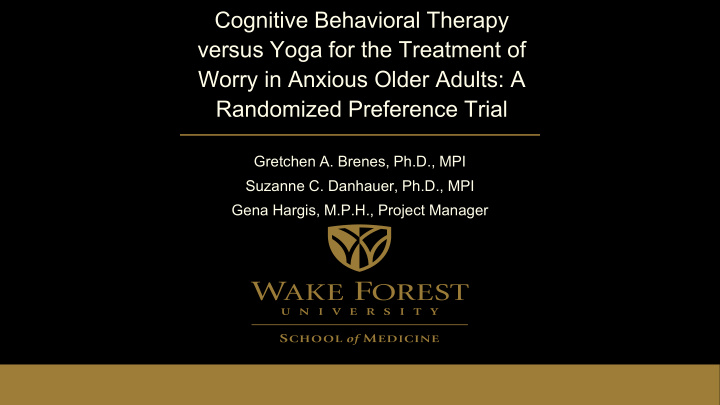



Cognitive Behavioral Therapy versus Yoga for the Treatment of Worry in Anxious Older Adults: A Randomized Preference Trial Gretchen A. Brenes, Ph.D., MPI Suzanne C. Danhauer, Ph.D., MPI Gena Hargis, M.P.H., Project Manager
Disclosures Dr. Brenes, Dr. Danhauer, and Ms. Hargis have nothing to disclose.
Background Anxiety disorders-most prevalent psychiatric disorders in older adults Associated with numerous negative outcomes Treatment of late-life anxiety
Why this study? Cognitive Behavior Therapy (CBT) delivered by telephone is successful in improving anxiety, depression, sleep, and quality of life Stakeholder Feedback: Wanted choice Wanted CBT as an option Wanted yoga as an option Did not want medication
Specific Aims Primary Aim: Compare the effects of CBT and yoga on worry Secondary Aim: Compare the effects of CBT and yoga on anxiety and sleep Exploratory Aims: Determine participant preference for CBT vs. yoga Examine preference effects on worry, anxiety, sleep, adherence to treatment, and attrition rates Examine selection effects on worry, anxiety, sleep, adherence to treatment, and attrition rates
Questions this study answers How does yoga compare with CBT for reducing worry and anxiety and improving sleep? When given a choice, which treatment do people prefer for reducing worry? Are treatment outcomes improved when people choose their treatment (preference and selection effects)? Are adherence rates higher when people choose treatments than when they are told which treatment they will receive? Are there differences in satisfaction based on whether a person chooses their treatment vs. being told which treatment they will receive?
Study Design for Randomized Preference Trial
Participants: Goal of N = 500 Inclusion criteria: ≥60 years elevated worry Exclusion criteria: currently receiving psychotherapy currently practicing yoga current alcohol/substance abuse dementia global cognitive impairment current psychotic symptoms active suicidal ideation change in psychotropic medications in the last month hearing loss
Recruitment Sources of recruitment identified by value system for age Physicians Newspaper vs social media Churches Community groups Neighborhood magazines Local community establishments
Recruitment: Lessons Learned Identify key community stakeholders for credibility Multiple exposures to recruitment materials from credible resources Visuals for postcard
Description of CBT 10 weekly telephone sessions with a study coach Workbook Worry control Cognitive behavioral model of anxiety Behavioral activation Relaxation Exposure therapy Cognitive restructuring Pain Sleep hygiene Relapse prevention Problem-solving
Description of Yoga Intervention 20 bi-weekly yoga classes Gentle Hatha yoga based on “Yoga for Seniors” book/program (by Carol Krucoff) Adapted for older adults and accommodates individuals of varying levels of physical functioning Focused on breathing, posture practice, and meditation/relaxation
Measures Week 0 Week 6 Week 11 Week 37 Penn State Worry Questionnaire-Abbreviated X X X X (PSWQ-A) (Primary Outcome) PROMIS Anxiety X X X X (Secondary Outcome) Insomnia Sleep Index X X X X (Secondary Outcome) PROMIS 29 X X X (Exploratory Outcome) PROMIS Depression X X X (Exploratory Outcome) PROMIS Physical Function X X X (Exploratory Outcome) GAD-7 X X X (Exploratory Outcome)
Stakeholder Engagement Clinical stakeholders are physicians who provide clinical care to older adults; assisted with recruitment Community stakeholders are local organizations (Shepherd’s Center) and local churches; assisted with advertisement and publicity; enhanced visibility and sustainability within the community Patient stakeholders are older adults with personal experience with worry/anxiety; provided feedback on measurement tools and interventions, assisted with development of recruitment strategies and materials, provided suggestions for timing and location of classes
Stakeholder Engagement: Lessons Learned Clinical stakeholders : relationships with clinician/patient Community stakeholders: multi-faceted community connection for sustainability Patient stakeholders : incorporating feedback from the population
Sample Characteristics Psychotropic Medication Use Number of Participants 500 Any 218(43.6%) Age [Mean (SD)] 66.5(5.2) Anti-depressants 145(29%) Gender Anxiolytics 100(20%) Male 67(13.4%) Anti-psychotics 10(2%) Female 433(86.6%) Stimulants 10(2%) Race Sleep medication 70(14%) African Am./Black 74(14.8%) Caucasian/White 394(78.8%) Other 32(6.4%) Education <8 th grade 1(0.2%) 8 -10 th grade 7(1.4%) 11-12 th grade 66(13.2%) >12 th grade 426(85.2%)
Answers to Study Questions How does yoga compare with CBT for reducing worry and anxiety and improving sleep? Both CBT and yoga improved worry, anxiety, and sleep, but CBT is superior to yoga for improving sleep outcomes.
Answers to Study Questions When given a choice, which treatment do people prefer for reducing worry? People chose CBT and yoga at an equal rate.
Answers to Study Questions Are treatment outcomes improved when people choose their treatment ? Choosing a treatment does not produce better results than being assigned to a treatment.
Answers to Study Questions Are adherence rates higher when people choose a treatment? Participants who chose CBT completed more sessions than participants who were randomized to CBT. Participants who chose yoga completed a similar number of sessions as participants who were randomized to yoga.
Answers to Study Questions Does satisfaction differ based on whether a person chose their treatment or not? People who chose their treatment were as satisfied as people assigned to a treatment.
Discussion CBT and yoga improved worry, anxiety, and sleep CBT was superior to yoga for improving sleep outcomes No preference or selection effects
Strengths Randomized preference trial: Compare randomized and preference effects Largest study of CBT and yoga for worry and anxiety Careful assessment of adherence and fidelity Stakeholder involvement
Limitations Willingness to be randomized Differences in frequency and format between CBT and yoga Predominantly white, well-educated sample Intervention specific barriers (transportation)
Take Home Messages Both CBT and yoga are helpful for reducing worry and anxiety in older adults. If someone has high worry and sleep problems, CBT is recommended. As a provider, making a specific recommendation of a treatment (CBT or yoga) does not produce better outcomes than encouraging the patient to choose a treatment.
Recommend
More recommend